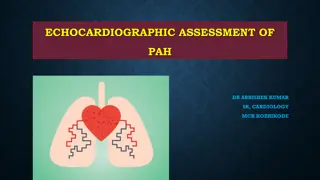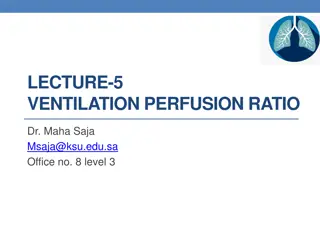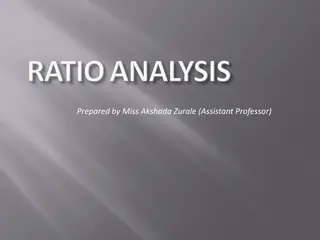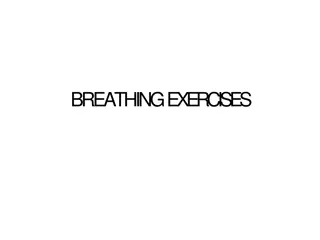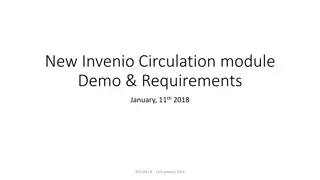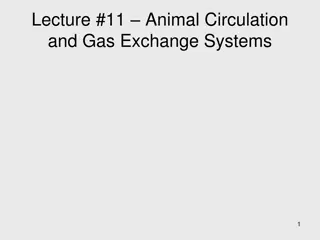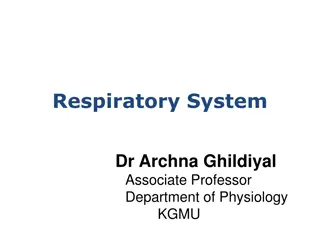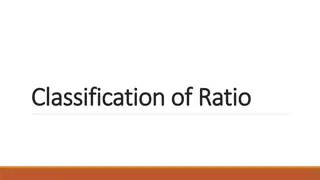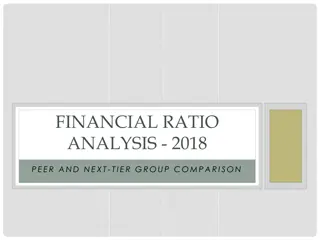Understanding Pulmonary Circulation and V/Q Ratio in Respiratory Physiology
Explore the high-pressure and low-pressure circulations supplying the lungs, the concept of physiological shunt in pulmonary circulation, different lung zones based on blood flow, V/Q ratio and its clinical significance, and abnormal V/Q ratio patterns. Delve into the role of pulmonary circulations in oxygenation and carbon dioxide exchange, with a focus on physiological shunts and their impact on blood oxygenation levels.
Download Presentation

Please find below an Image/Link to download the presentation.
The content on the website is provided AS IS for your information and personal use only. It may not be sold, licensed, or shared on other websites without obtaining consent from the author. Download presentation by click this link. If you encounter any issues during the download, it is possible that the publisher has removed the file from their server.
E N D
Presentation Transcript
L-6 Ventilation, perfusion, ratio Color index: Helpful video Main text Important Doctor notes Boys slides Girls slides Extra Editing file
Objectives: Recognize the high pressure and low pressure circulations supplying the lung Identify the meaning of the physiological shunt in the pulmonary circulation State the different lung zones according to the pulmonary blood flow Define the V/Q ratio and its regional variation Explain the clinical significance of the V/Q ratio Describe the abnormal patterns of the V/Q ratio vice, shunt and dead space patterns
In female slides only Pulmonary circulations The pulmonary arterial system is shown in blue to indicate that the blood carried is oxygen-poor The pulmonary venoussystem is shown in red to indicate that the blood transported is oxygen-rich Blood volume of the lungs : 450 ml 9% of total blood volume Approximately 70 ml in pulmonary capillaries Lungs serve as blood reservoir (100-250 ml)
Pulmonary circulations Pulmonary circulations Low-pressure/high-flow circulation High-pressure/low-flow circulation Supplies systemic arterial blood to: Trachea Bronchial tree (including terminal bronchioles) Supporting tissues of lung 0uter coats (adventitia) of pulmonary arteries & veins Supplies venous bloodfrom all parts of the body to alveolar capillaries where oxygen (O2) is added & carbon dioxide (CO2) is removed. Bronchial arteries: branches of thoracic aorta. Pulmonary artery (receives blood from right ventricle) and its arterial branches carry blood to alveolar capillaries for gas exchange. Pulmonary veins then return blood to left atrium to be pumped by left ventricle through systemic circulation. Supply most of systemic arterial blood at a pressure that is only slightly lower than aortic pressure.
In female slides only Physiological shunt 1 It is defined as a diversion through which the venous blood is mixed with arterial blood Flow of deoxygenated blood from bronchial circulation into pulmonary veins without being oxygenated makes up part of normal physiological shunt 2 3 Flow of deoxygenated bloodfrom thebesian veins into cardiac champers directly. 4 Physiological shunt results in venous admixture ( mixing of oxygenated blood with deoxygenated blood)
Physiological shunt 1 The blood that flows to lungs through small bronchial arteries that originate from the systemic circulation amounts to 1 - 2% of the total cardiac output. 1 2 The bronchial arterial blood is oxygenated blood, supplies the supporting 2 tissues of the lungs,including the connective tissue,septa,and large and small bronchi 3 3 4 4
shunts In Male Slides Only A portion of the pulmonary blood flow that bypassesthe alveoli (no gas exchange) Shunt Bronchial blood flow & coronary blood flow (2%) bypasses the alveoli. Physiological shunt Example: right to left shunt Will not be treated by high O2 supply Useful diagnostic tool. Abnormal shunt
Regulation of Pulmonary Blood Flow Regulation of pulmonary Blood flow The major factor regulating pulmonary blood flow is the partial pressure of O2 in alveolar gas (PaO2 ) Decrease in PAO2 below 70 mmHg > pulmonary vasoconstriction Adaptive mechanism: blood flow is directed away from poorly ventilated region Example: In high altitude PaO2 is reduced > global vasoconstriction Other factors: 1. 2. 3. 4. 5. Cardiac output Decreased alveolar oxygen Chemical factors,vasoconstrictor or dilator Hydrostatic pressure Physical activity Fetal pulmonary blood flow circulation is about 15% of cardiac output due to global vasoconstriction.
Effect of hydrostatic pressure on blood flow Lowest point in lungs: normally ~30 cm below highest point this represents 23 mm Hg pressure difference > ~15 mmHg of which is above the heart & 8 below it. Gravitational effect : hydrostatic pressure is affected by gravity pulmonary arterial pressure in uppermost portion of the lung of a standing person is ~15 mmHg less than pulmonary arterial pressure at the level of the heart. Pressure in the lowest portion of lungs is ~8 mmHg greater. Position: In Standing position at rest > there is little flow in the top of the lung In supine position > blood flow is nearly uniform Pressure differenceshave profound effects on blood flow through different areas of lungs the effect determines/depicts blood flow per unit of lung tissue at different levels of lung in upright person.
Regulation of Pulmonary Blood Flow Regulation of pulmonary Blood flow The major factor regulating pulmonary blood flow is the partial pressure of O2 in alveolar gas (PaO2 ) Decrease in PAO2 below 70 mmHg > pulmonary vasoconstriction Adaptive mechanism: blood flow is directed away from poorly ventilated region Example: In high altitude PaO2 is reduced > global vasoconstriction Other factors: 1. 2. 3. 4. 5. Cardiac output Decreased alveolar oxygen Chemical factors,vasoconstrictor or dilator Hydrostatic pressure Physical activity Fetal pulmonary blood flow circulation is about 15% of cardiac output due to global vasoconstriction.
In female slides only Distribution of ventilation The right lung is slightly better ventilated than the left. In a lateral position: The dependent lung is better ventilated in a spontaneouslybreathing patient The non-dependent lung is better ventilated in a ventilated patient In an erect patient : -the bases of the lung are better ventilated -The weight of lung above compresses the lung below,improvingthe compliance of dependent lung whilst stretching the non-dependent lung This is only significant at low inspiratory flow rates The V/Q ratio in the bases is~0.6 The V/Q ratio in the apices is > 3
In female slides only Distribution of perfusion The pulmonary circulation is a low pressure circulation Gravity therefore has a substantial effect on fluid pressure Consequently, the distribution of blood throughout the lungs is uneven The bases perfused better than the apices
Effect of hydrostatic pressure gradient in the lungs on regional pulmonary blood flow Local alveolar capillary pressure in that area of lung never rises higher than alveolar air pressure during any part of cardiac cycle (alveolar pressure (PALV) is more greater than arterial pressure) almostno blood flowduring all portions of cardiac cycle. Almost closure of capillaries Zone 1 Systolic pressure > alveolar air pressure diastolic pressure < alveolar air pressure only during peaks of pulmonary arterial pressure. intermittent blood flow Zone 2 Alveolar (pulmonary)capillary pressure and arterial pressure > alveolar air pressure during the entire cardiac cycle continuous blood flow Zone 3 Normally, lungs have only zones 2 & 3 blood flow: Zone 2 (intermittent flow) in the apices. Zone 3 (continuous flow) in all the lower areas.
Exercise & Blood Flow at different levels in the lung In the standing position at rest, there is little flow in the top of the lung but about five times as much flow in the bottom. The blood flow in all parts of the lung increases during exercise A major reason for increased blood flow is the pulmonary vascular pressures rise enough during exercise to convert the lung apices from a zone 2 pattern into a zone 3 pattern of flow.
Dead space & its effect on ventilation 1-Anatomical dead space. - - - Is the volume of air in respiratory conducting pathways. 150 ml = of tidal volume. Air in dead space expired first. 2-Functional dead space. - Alveoli that tend to act in gas exchange due to collapse or obstruction. 3-physiological dead space. - The summation of alveolar & anatomical dead space. - In Male slides Only
Ventilation Perfusion (V/Q) Ratio V/Q ratio: - Is the ratio of alveolar ventilationto pulmonaryblood flow perminute. - (V) alveolar ventilation at rest = 4.2 L/min - ( perfusion-Q ) pulmonary blood flow = right ventricular output( 5L/min) - Normal V/Q ratio = 4.2 / 5 = 0.84 - Alveolar ventilation is 80% of value for pulmonary blood flow if tidal volume & cardiac output are normal - Exchange of O2&Co2 is nearly optimal, Alveolar PO2 is 104 mmHg. - Alveolar PCO2 is 140 mmHg.
Variation in V/Q in the Zones of Lung Apex is more ventilated than perfused. Apex V/Q ratio = 3 Moderate degree of physiologic or normal dead space. ( mimics dead space ) Base is more perfused than ventilated. Base V/Q ratio = 0.6 Physiologic or normal shunt.( mimics shunt ) V/Q is uneven in the three zones: Average V/Q ratio = 0.84 During exercise & lying flat in bed, V/Q ratio becomes more homogenous among different parts of the lung.
In female slides only Alveolar PO2 and PCO2 When V/Q equals = 0 - When ( V ) is zero , like in case of bronchial obstruction , the V/Q ratio will be zero even if there is perfusion ( Q). - Without alveolar ventilation , air in alveolus = venous return to lungs. - The normal venous blood (V ) has a PO2 of 40mmHg and PCO2 of 45mmHg. (Shunt blood ). - these are the normal partial pressures of O2&Co2 in alveoli that have blood flow but no ventilation.
In female slides only Alveolar PO2 and PCO2 When V/Q ratio equals Infinity - There is ventilation but no perfusion ( Q) , like in case of pulmonary artery occlusion by thrombus or embolism , so the V/Q ratio will be infinite. - There will be no capillary blood flow to carry O2 or Co2 to alveoli. - The inspired air has no O2 to the blood, or Co2 from the blood. - normal inspired and humidified air has a PO2 of 149 mmHg and a PCO2 of 0 mmHg & these will be the partial pressures of the two gases in alveoli.
Importance of the V/Q Ratio - - - Physiological shunt : total quantitative amount of shunted blood per minute. any mismatch in ratio result in hypoxia Main function is determining of of state of oxygenation in body Less than normal More than normal Part of venous blood pass through pulmonary veins without oxygenated ( shunted blood ) No exchange of gas through respiratory membrane of affected alveoli Physiologic dead space , high ventilation & low alveolar blood flow i Ratio zero/infinity
Abnormalities of the V/Q Ratio Changes in V/Q ratio can be caused by changes in ventilationor perfusion or both. Airway obstruction alveolar ventilationis affected (shunt). ( = 0 ) Pulmonary embolism perfusion is affected (dead space). ( = infinity )
Female slide only Causes of V/Q mismatch Pulmonary edema Pneumonia Asthma Causes of V/Q dismatch Airway obstruction COPD Chronic bronchitis
Abnormal V/Q Ratio in COPD - - Eg: Chronic smokers with emphysema COPD: bronchial obstruction in some areas & destruction of alveolar septa in other areas with patent alveoli. - COPD patients have some areas of the lung exhibit serious physiologic shunt & other areas serious physiologic dead space. - Both conditions tremendously decrease the effectiveness of the lungs as gas exchange organs as little as 10% of normal. - COPD is the most prevalent cause of pulmonary disability today.
In male slides only Clinical Application Clinical Application
For more questions please click on the icon MCQ 1 A 2.B 3.C 4.A 1.Example of abnormal shunt is ? A) Right to left B) Left to right C)Right D) Left 2. The blood flow in all parts of the lung .during exercise ? A) decrease B) increase C) doesn t change D) stop 3. Apex in zone 1 with V/Q ratio = 3 is ? A) less ventilated B) more perfused C) mimics dead space D) mimics shunt 4. A patient comes with asthma , what would be the affected process ? Alveolar ventilation Perfusion Both None
SAQ Q1) Enumerate the type of pulmonary circulations and what they supplies? Q2) what is the Causes of V/Q mismatch Q3) Enumerate the factors of regulation of pulmonary blood flow ? 1)High-pressure/low-flow circulation, Supplies systemic arterial blood to Trachea ,Bronchial tree ,Supporting tissues of lung ,0uter coats Low-pressure/high-flow circulation , Supplies venous blood from all parts of the body to alveolar capillaries 2) COPD,Pneumonia,Asthma,Pulmonary edema 3) Cardiac output,Decreased alveolar oxygen,Chemical factors,vasoconstrictor or dilator,Hydrostatic pressure
Team leaders Deema aljuribah Mishal Alsuwayegh Waleed Alrashoud Team members Maram Beyari Raghad Alnadeef Hend Almogary Farah Alfayez Kadi Khalid aldoosari Farah mohammed Alqazlan Ghada Binslmah Shatha Alshabani Jana alhazmi Faisal Ali Ibraheem Alkanhal Saad Alhammad Emad Almutairi Ahmad Almarshed Salman Almutaz Osama Alzahrani Othman Aldraihem Abdullah Alqarni Rayan Alotaibi Faisal Alkhunein Mishari Alenezi Bandar Almutiri Fahad Alhelelah Rayan Bosaid Physio442@gmail.com




